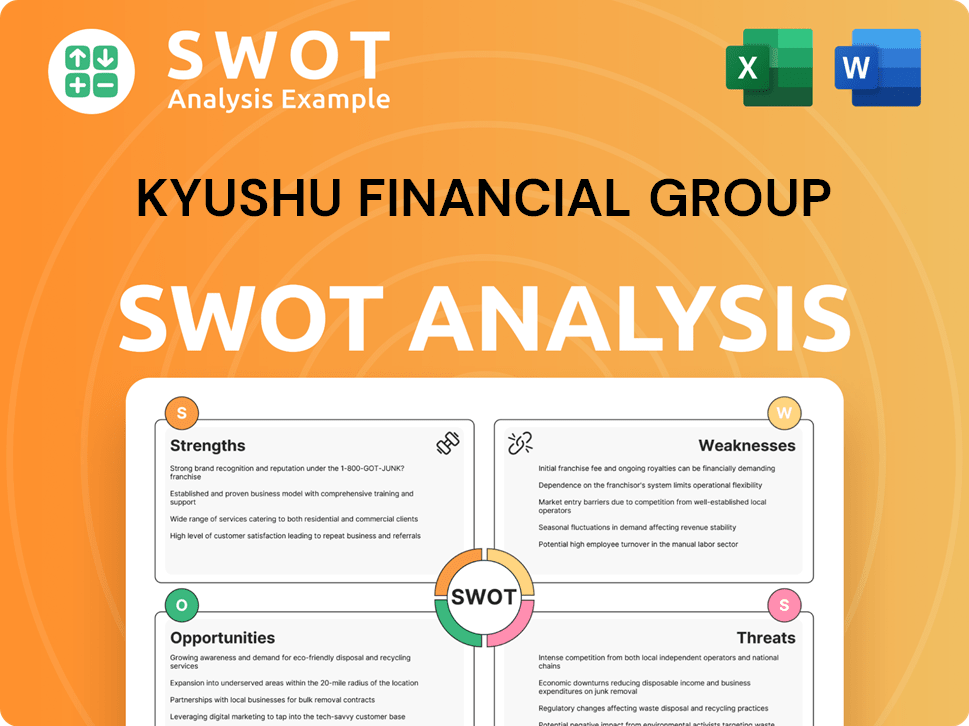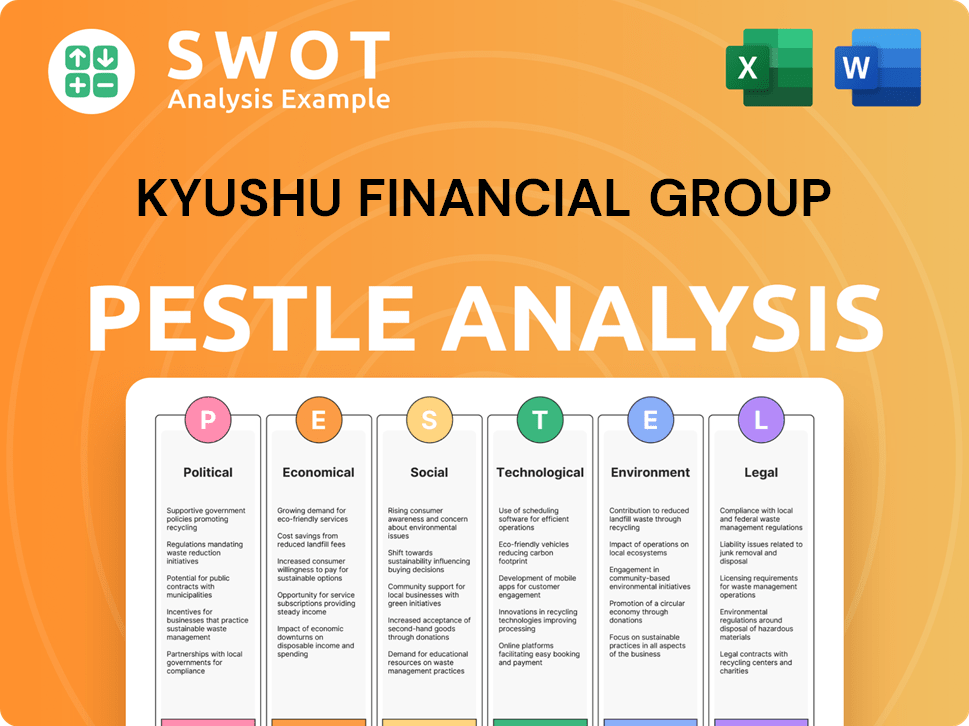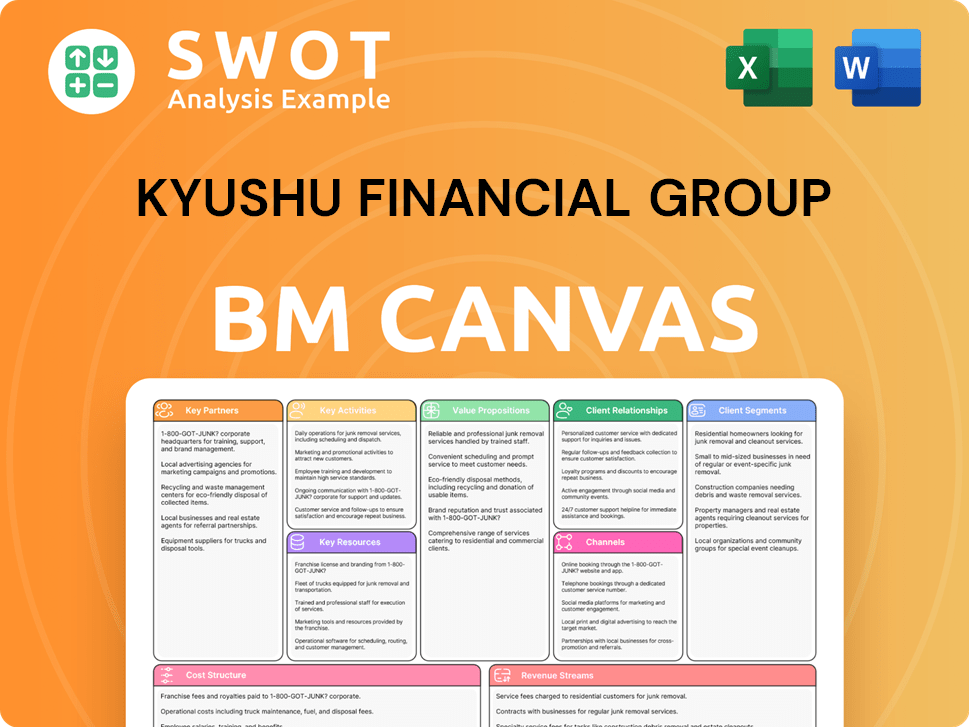Kyushu Financial Group Bundle
Can Kyushu Financial Group Navigate the Future of Finance?
Established in 2015, Kyushu Financial Group (KFG) has rapidly become a key player in Japan's regional banking sector. With a strong foothold in the Kyushu region, KFG offers comprehensive financial services, including banking, leasing, and credit cards. But what are the Kyushu Financial Group SWOT Analysis and the strategic plans driving its future growth?

Kyushu Financial Group's financial prospects are closely tied to its ability to capitalize on the regional economy's unique strengths, including the burgeoning semiconductor industry and tourism. Its growth strategy focuses on strategic expansion and leveraging innovation to maintain a strong financial outlook. This analysis delves into KFG's market position, examining its potential for sustainable growth and its impact on local businesses, providing valuable insights for investors and strategists alike.
How Is Kyushu Financial Group Expanding Its Reach?
Kyushu Financial Group's (KFG) expansion initiatives are strategically designed to bolster the regional economy and enhance its financial services offerings. The group focuses on deepening its comprehensive financial functions and expanding 'Regional Value Co-creation businesses.' This approach is particularly crucial given the significant capital investments in key local industries, such as the electronic device sector, driven by major players like TSMC entering the region.
The growth strategy emphasizes organic expansion and strategic partnerships to foster regional revitalization. KFG aims to strengthen its business framework in growing Asian markets by hiring foreign employees, signaling a long-term perspective on international ties and market opportunities. This approach is vital for sustaining growth and adapting to the evolving financial landscape.
KFG's focus on regional economic development is further demonstrated through its subsidiaries' initiatives, such as Kagoshima Bank's partnership for promoting GX (Green Transformation) in the livestock industry and industrial development of Kagoshima Prefecture, as of April 2024. These efforts aim to reduce GHG emissions and enhance productivity, reflecting a commitment to sustainable growth and environmental responsibility.
KFG actively promotes regional economic development through its 'Regional Value Co-creation businesses.' This involves supporting key local industries and fostering partnerships to drive sustainable growth. This strategy is crucial for the long-term financial prospects of the group.
KFG leverages strategic partnerships to expand its reach and enhance its service offerings. Collaborations with other financial institutions and industry players are key to its growth strategy. These partnerships allow KFG to tap into new markets and strengthen its competitive position.
KFG is expanding its presence in growing Asian markets. The hiring of foreign employees indicates a commitment to building strong international ties and expanding its customer base. This expansion is a key part of KFG's long-term growth strategy.
KFG is committed to sustainable growth through initiatives like the GX partnership in Kagoshima Prefecture. These efforts demonstrate a focus on environmental responsibility and contribute to the long-term financial prospects of the group. These initiatives are vital for the future.
In the leasing sector, the partnership between Tokyo Century and Fukuoka Financial Group (FFG) exemplifies the trend of strengthening area-specific strategies. FFG Lease, now a 50/50 equity-method affiliate of both companies since April 2024, is expanding its branch network with new openings in Kitakyushu, Kumamoto, and Kurume, and plans for a southern Kyushu branch. This regional collaboration and focused expansion within key business segments demonstrate a pathway for growth within the Kyushu financial landscape. For more insights into the target market, consider exploring the Target Market of Kyushu Financial Group.
KFG's expansion plans are multifaceted, focusing on both organic growth and strategic partnerships. This approach is designed to capitalize on regional economic opportunities and strengthen its market position. These initiatives are crucial for the group's future financial performance.
- Deepening Regional Comprehensive Financial Functions: Enhancing services to support local businesses and industries.
- Expanding 'Regional Value Co-creation Businesses': Focusing on initiatives that drive regional economic development.
- Strategic Partnerships: Collaborating with other financial institutions and industry players to expand reach and offerings.
- International Expansion: Targeting growth in Asian markets through strategic hiring and market entry.
Kyushu Financial Group SWOT Analysis
- Complete SWOT Breakdown
- Fully Customizable
- Editable in Excel & Word
- Professional Formatting
- Investor-Ready Format

How Does Kyushu Financial Group Invest in Innovation?
Kyushu Financial Group (KFG) is actively embracing innovation and technology to fuel its Growth Strategy, focusing on digital transformation (DX) to enhance customer experiences and operational efficiency. This strategy is crucial for navigating the evolving landscape of the Banking Sector and maintaining a competitive edge in the Financial Services industry. KFG's approach highlights the importance of integrating cutting-edge technologies and fostering a culture of innovation to drive sustainable growth.
A key aspect of KFG's strategy involves leveraging data and collaborative efforts, such as the JR KYUPO app, to provide value to customers. This initiative enables customers to utilize points across various services, improving convenience and customer loyalty. Furthermore, KFG is committed to improving operational efficiency through automation and mechanization, which supports employee working-style reforms and overall productivity gains.
KFG's commitment to innovation extends to addressing environmental challenges through technological advancements, such as Kagoshima Bank's partnership to promote GX in the livestock industry. This includes initiatives to reduce greenhouse gas emissions using technology. KFG's proactive stance in this area underscores its commitment to sustainable growth and its role in the Regional Economy.
KFG is heavily investing in digital transformation (DX) to improve customer experiences and operational efficiency. This includes the development of digital platforms and services.
The effective use of data is a core component of KFG's innovation strategy. This involves analyzing customer data to personalize services and improve decision-making.
KFG is engaging in collaborative efforts, such as the JR KYUPO app, to enhance customer value. These collaborations aim to integrate services and improve customer convenience.
Automation and mechanization are being implemented to support employee working-style reforms and boost productivity. This includes streamlining internal processes.
KFG is addressing environmental challenges through technological advancements, such as promoting GX in the livestock industry. This includes reducing greenhouse gas emissions.
The Financial Services Agency (FSA) promotes FinTech and AI use, creating a supportive environment for KFG's technology-driven growth. This encourages innovation within the financial sector.
KFG's innovation strategy is multifaceted, focusing on digital transformation, data utilization, and sustainability. These strategies are designed to enhance customer value, improve operational efficiency, and support environmental goals.
- Digital Transformation (DX): Implementing digital platforms and services to improve customer experiences and operational efficiency.
- Data Analytics: Utilizing data to personalize services, improve decision-making, and identify growth opportunities.
- Automation and Mechanization: Streamlining internal processes to support employee working-style reforms and increase productivity.
- Environmental Initiatives: Promoting GX in various industries to reduce greenhouse gas emissions and support sustainability.
- Regulatory Compliance: Aligning with the FSA's guidelines to ensure the sound and effective use of AI and other technologies.
Kyushu Financial Group PESTLE Analysis
- Covers All 6 PESTLE Categories
- No Research Needed – Save Hours of Work
- Built by Experts, Trusted by Consultants
- Instant Download, Ready to Use
- 100% Editable, Fully Customizable

What Is Kyushu Financial Group’s Growth Forecast?
Kyushu Financial Group's (KFG) financial performance showcases a robust trajectory, particularly within the Banking Sector. The fiscal year ending March 31, 2025, marked significant gains in key financial metrics. This performance underscores the effectiveness of its Growth Strategy and its strong position in the Financial Services sector.
The company's strategic initiatives are clearly reflected in its financial outcomes. KFG's ability to enhance capital efficiency and reduce the cost of capital, as demonstrated by its share repurchase program, further supports its growth prospects. These actions are crucial for maintaining a competitive edge in the Regional Economy.
The company's financial outlook for the upcoming fiscal years indicates continued expansion and profitability. These projections, coupled with its dividend policy, highlight KFG's commitment to delivering value to its shareholders and its confidence in its long-term Financial Prospects.
For the fiscal year ending March 31, 2025, KFG reported net sales of 39,338 million yen, a 17.4% increase year-on-year. This growth reflects increased operational efficiency and market penetration. The rise in revenue is a key indicator of successful strategic execution.
Operating profit reached a record high of 5,651 million yen, up 21.9% year-on-year. This significant increase highlights improved cost management and operational excellence. The achievement underscores the effectiveness of KFG's financial strategies.
Profit attributable to owners of the parent increased to 3,569 million yen, a 17.1% increase year-on-year. This growth demonstrates the company's ability to generate value for its shareholders. This is a key indicator of the company's financial health.
The annual dividend for the fiscal year ended March 31, 2025, was 53.00 yen per share, an increase of 23.00 yen from the previous year. A planned annual dividend of 56.00 yen per share is set for the fiscal year ending March 31, 2026, including a 10th Anniversary Commemorative Dividend. This reflects the company's commitment to shareholder returns.
KFG's future outlook includes ambitious targets for revenue and net income. The company's focus on shareholder value, as seen through its dividend increases and share repurchase program, is a strong indicator of its commitment to long-term growth and financial stability. For a deeper dive into the company's strategic planning, consider reading about Kyushu Financial Group's market analysis.
Net sales are projected to reach 241,400 million yen for the fiscal year ending March 2026. This forecast indicates continued expansion and strategic growth. This projection reflects the company's confidence in its strategies.
Net sales are projected to reach 251,400 million yen for the fiscal year ending March 2027. This further growth demonstrates the company's long-term strategic planning. The increase underlines the company's positive outlook.
Net income is forecasted at 32,500 million yen for the fiscal year ending March 2026. This projection reflects the company's profitability goals. This is a key indicator of financial success.
Net income is forecasted at 42,650 million yen for the fiscal year ending March 2027. This demonstrates the company's commitment to sustained profitability. The forecast shows the company's long-term financial health.
The Dividend on Equity (DOE) ratio is projected to be 3.0% for the fiscal year ending March 31, 2025. This reflects the company's commitment to shareholder returns. The DOE ratio is a key financial metric.
The Dividend on Equity (DOE) ratio is projected to be 3.1% for the fiscal year ending March 31, 2026. This further emphasizes the company's dedication to shareholder value. This ratio highlights the company's financial strategy.
Kyushu Financial Group Business Model Canvas
- Complete 9-Block Business Model Canvas
- Effortlessly Communicate Your Business Strategy
- Investor-Ready BMC Format
- 100% Editable and Customizable
- Clear and Structured Layout

What Risks Could Slow Kyushu Financial Group’s Growth?
The Kyushu Financial Group (KFG) faces several potential risks that could influence its Growth Strategy and Financial Prospects. These challenges include market competition within the Banking Sector and broader Financial Services, as well as the impact of global economic trends like inflation and rising interest rates. The group must also navigate regulatory changes and technological disruptions, which demand continuous adaptation to maintain its competitive edge.
The company's regional focus presents both opportunities and vulnerabilities, as economic shifts in the Kyushu area directly affect its performance. While the presence of major industries like semiconductor manufacturing offers a positive counterbalance, KFG must proactively manage various risks. This necessitates a strategic approach that includes diversification, technological advancement, and robust risk management practices.
KFG's ability to adapt to these challenges will be crucial for realizing its Future Growth Opportunities. The company's strategic initiatives, such as investments in digital transformation and sustainable development, are designed to mitigate these risks and foster long-term financial success. Understanding these potential obstacles is essential for investors and stakeholders assessing KFG's future performance.
The Kyushu Financial Group operates within a competitive environment in the Financial Services sector. Competitors range from major national banks to regional financial institutions and emerging FinTech companies. The competitive landscape requires the KFG to continuously innovate and improve its services to retain and attract customers. For more information about the competitive landscape, you can read Competitors Landscape of Kyushu Financial Group.
Economic fluctuations, including inflation and interest rate changes, pose significant risks. These factors can affect loan demand, asset values, and overall profitability. The group must carefully manage its financial instruments and capital allocation to mitigate these risks. The Bank of Japan's monetary policy also plays a crucial role in influencing the economic climate.
Changes in financial regulations, particularly by the Financial Services Agency (FSA), can create compliance costs and operational challenges. KFG needs to adapt to new rules regarding remittances, payments, and credit services. The rise of FinTech companies further complicates the regulatory environment, requiring constant monitoring and strategic adjustments.
The rapid advancement of technology, including AI, presents both opportunities and risks. FinTech companies and other digital platforms are disrupting traditional Financial Services. KFG must invest in digital transformation and maintain technological agility to remain competitive. This includes embracing new technologies and enhancing customer experiences.
KFG's strong regional focus makes it susceptible to economic conditions in the Kyushu area. Economic downturns or shifts in key industries can directly impact its financial performance. The company's performance is closely tied to the Regional Economy. While the entry of new industries can help, diversification remains important.
Managing human capital and internal resources is also a potential obstacle. KFG must attract and retain skilled employees, particularly in areas such as corporate consulting, IT/DX, and market investment. Proactive recruitment and the hiring of foreign employees are critical for innovation and international expansion. The company has been focused on talent acquisition to meet these needs.
KFG employs several strategies to mitigate risks, including diversifying its business activities across Banking Sector, leasing, credit cards, securities, and research. The group actively monitors market conditions and adjusts its strategies accordingly. They focus on sustainable development through ESG initiatives, such as setting targets for reducing CO2 emissions, to manage environmental risks effectively.
Investing in digital transformation and AI is a key part of KFG's strategy to stay competitive. This includes developing new digital services, enhancing customer experiences, and improving operational efficiency. The group is actively exploring partnerships with FinTech companies to foster innovation. KFG's efforts in this area are crucial for long-term Financial Prospects.
Kyushu Financial Group Porter's Five Forces Analysis
- Covers All 5 Competitive Forces in Detail
- Structured for Consultants, Students, and Founders
- 100% Editable in Microsoft Word & Excel
- Instant Digital Download – Use Immediately
- Compatible with Mac & PC – Fully Unlocked

Related Blogs
- What are Mission Vision & Core Values of Kyushu Financial Group Company?
- What is Competitive Landscape of Kyushu Financial Group Company?
- How Does Kyushu Financial Group Company Work?
- What is Sales and Marketing Strategy of Kyushu Financial Group Company?
- What is Brief History of Kyushu Financial Group Company?
- Who Owns Kyushu Financial Group Company?
- What is Customer Demographics and Target Market of Kyushu Financial Group Company?
Disclaimer
All information, articles, and product details provided on this website are for general informational and educational purposes only. We do not claim any ownership over, nor do we intend to infringe upon, any trademarks, copyrights, logos, brand names, or other intellectual property mentioned or depicted on this site. Such intellectual property remains the property of its respective owners, and any references here are made solely for identification or informational purposes, without implying any affiliation, endorsement, or partnership.
We make no representations or warranties, express or implied, regarding the accuracy, completeness, or suitability of any content or products presented. Nothing on this website should be construed as legal, tax, investment, financial, medical, or other professional advice. In addition, no part of this site—including articles or product references—constitutes a solicitation, recommendation, endorsement, advertisement, or offer to buy or sell any securities, franchises, or other financial instruments, particularly in jurisdictions where such activity would be unlawful.
All content is of a general nature and may not address the specific circumstances of any individual or entity. It is not a substitute for professional advice or services. Any actions you take based on the information provided here are strictly at your own risk. You accept full responsibility for any decisions or outcomes arising from your use of this website and agree to release us from any liability in connection with your use of, or reliance upon, the content or products found herein.